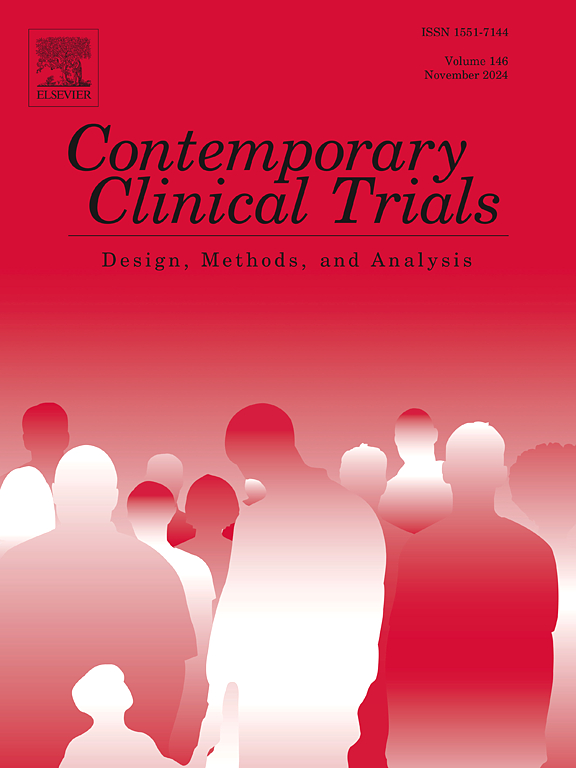招募和保留在现实世界的比较有效性试验,以改善糖尿病自我保健行为
IF 2
3区 医学
Q3 MEDICINE, RESEARCH & EXPERIMENTAL
引用次数: 0
摘要
需要有效的策略来招募和留住试验参与者,特别是少数族裔患者。本文描述了日常生活中糖尿病管理(MODEL)研究的招募阶段,重点研究了预测研究入组和保留的因素。方法MODEL研究是一项实用的临床试验,旨在比较短信和健康指导与教育材料在改善非裔美国人糖尿病患者自我保健方面的效果。描述性统计包括计数和比例被用来描述招聘过程。使用多变量逻辑回归来检查与研究入组和保留相关的因素。结果在接触的4310例患者中,预筛选2300例(53.4%),筛选1221例(28.3%),随机筛选666例(15.4%)符合筛选条件的患者。在签署同意后被排除在外的人中,约有48%的人被排除在外是因为他们没有回复短信和/或语音信息,26.8%的人最近没有进行糖化血红蛋白检测。在这些筛查者中,大多数是通过糖尿病登记处联系的(70.5%),然后是医生转诊(15.7%)。随机分组的患者比被排除的患者具有更高的教育水平,并且健康指导组的患者完成研究的可能性明显较低。研究表明,技术障碍,没有定期随访,不知道他们的慢性病,是少数民族人口的招聘障碍。实际参与登记处可以促进招募服务不足的少数民族人口。此外,参加时间密集型健康指导干预的患者的研究保留率最低。本文章由计算机程序翻译,如有差异,请以英文原文为准。
Recruitment and retention in a real-world comparative effectiveness trial to improve diabetes self-care behaviors
Background
Effective strategies are needed to recruit and retain participants in trials, especially for minority patients. This paper describes recruitment phases of the Management of Diabetes in Everyday Life (MODEL) study, with an emphasis on examining factors that predicted study enrollment and retention.
Methods
The MODEL study was a pragmatic clinical trial designed to compare the effectiveness of Text Messaging versus Health Coaching with Educational Materials on improving diabetes self-care among patients of African-American race with uncontrolled diabetes. Descriptive statistics including counts and proportions were used to describe the recruitment process. Multivariable logistic regression was used to examine factors associated with study enrollment and retention.
Results
Of 4310 patients contacted, 2300 (53.4 %) were prescreened, of those 1221 (28.3 %) were screened, and 666 (15.4 %) eligible screenees were randomized. Of those who got excluded after signing consent, about 48 % were excluded because they did not respond to text messages and/or voice messages and 26.8 % did not have a recent A1c test. Of those screened, the majority were contacted using a diabetes registry (70.5 %) followed by physician referral (15.7 %). Patients randomized had higher education levels than those who were excluded, and patients in the Health Coaching were significantly less likely to complete the study.
Conclusions
The study showed that technology barriers, not having regular follow-up, and being unaware of their chronic conditions, are recruitment barriers for minority populations. Practice participation in a registry can facilitate recruitment of underserved minority populations. Furthermore, patients participating in the time-intensive health coaching intervention experienced lowest study retention.
求助全文
通过发布文献求助,成功后即可免费获取论文全文。
去求助
来源期刊
CiteScore
3.70
自引率
4.50%
发文量
281
审稿时长
44 days
期刊介绍:
Contemporary Clinical Trials is an international peer reviewed journal that publishes manuscripts pertaining to all aspects of clinical trials, including, but not limited to, design, conduct, analysis, regulation and ethics. Manuscripts submitted should appeal to a readership drawn from disciplines including medicine, biostatistics, epidemiology, computer science, management science, behavioural science, pharmaceutical science, and bioethics. Full-length papers and short communications not exceeding 1,500 words, as well as systemic reviews of clinical trials and methodologies will be published. Perspectives/commentaries on current issues and the impact of clinical trials on the practice of medicine and health policy are also welcome.

 求助内容:
求助内容: 应助结果提醒方式:
应助结果提醒方式:


